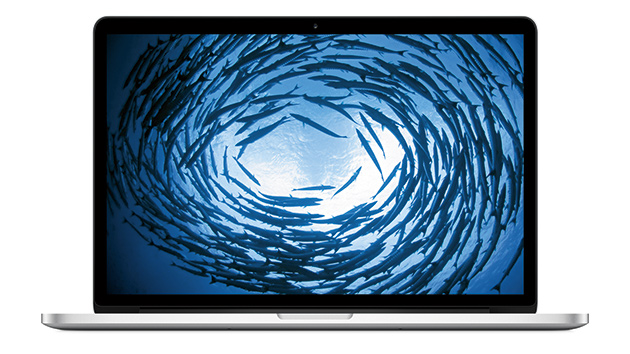Faster Flash Memory, Speedier GPUs, But No Big Leap in Processor Power
Apple has upgraded the 15-inch MacBook Pro with Retina display. What's new on the outside and under the hood?
One thing that's not new is the processor architecture. Apple has reportedly once again used Intel Haswell CPUs, owing to delayed shipments of new 14nm Broadwell chips. (The next generation of Intel CPUs, Skylake, is already due out later this year, giving Broadwell an unexpectedly short shelf life.)
So the new MBP is available with 2.2 GHz or 2.5GHz quad-core Intel Core i7 processors. A 2.8 GHz quad-core CPU can be selected in a custom configuration. Despite staying with the old chips, Apple has squeezed some extra life out of its hardware this time around, promising a one-hour increase in battery life, which now reaches a claimed nine-hour maximum.
Both models have PCIe-based flash storage, and that's where the performance gains in this model are likely to come from. Apple said the new flash storage runs "up to 2.5 times faster" than previous generations, with throughput boosted impressively to a maximum 2 GB/sec. The low-end model has 256 GB and the high-end model has 512 GB, while a custom-configured system can be bumped up to 1 TB.
Graphics chips in the high-end model have been swapped out, with the AMD Radeon R9 M370X replacing Nvidia GeForce GT 750M GPUs in previous models. Apple says the switch provides "up to 80 percent faster performance." (The low-end model has standard Intel Iris Pro graphics.) 16 GB of RAM is standard in both system configurations.
Finally, the 15-inch MBP now has the Force Touch pad that originally showed up on its 13-inch little brother back in March. The Force Touch trackpod has sensors that measure the amount of pressure being applied, allowing the system to distinguish between, say, a click that selects an item and a click that opens it. The trackpad doesn't actually "click" like a button but instead offers haptic force feedback through something Apple calls the Taptic Engine. It's the same technology that's used to convey a sense of a click to users of the Apple Watch, and it's expected to show up on the iPhone soon.
Apple has released an API allowing third-party developers to access the Force Touch capabilities, but it remains to be seen if and when those features will be supported by makers of content creation software, including Apple's own Final Cut Pro.
Crafts: Editing VFX/Animation
Sections: Technology
Topics: apple MacBook Pro macbook pro with retina display retina display
Did you enjoy this article? Sign up to receive the StudioDaily Fix eletter containing the latest stories, including news, videos, interviews, reviews and more.











Leave a Reply